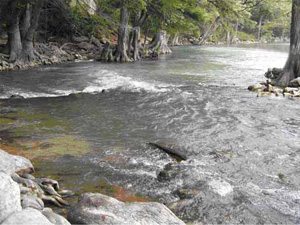Instream Flows in Texas

A sound natural environment is essential not only for maintaining the quality of life enjoyed by Texans and future generations of Texans, but also for maintaining a strong state economy. Healthy aquatic ecosystems conserve biodiversity and support many industries including recreation, tourism, commercial fishing, transportation and water supply. With the population of Texas projected to nearly double in the next 50 years, the demand for water is anticipated to exceed the current supply requiring increased usage of both surface water and ground water resources. Concern has arisen that water development without adequate provisions to protect instream flows will lead to degraded aquatic ecosystems.
What is Instream Flow?
In the most basic sense, instream flow is water flowing in a stream channel. However, the term instream flow also implies flowing water that supports a larger stream ecosystem, including riparian (stream bank) and floodplain areas. For the purposes of this program, instream flow is defined as the flow regime (quantity and timing of flow) that is adequate to maintain an ecologically sound environment.
The goal of an instream flow study is to identify appropriate flow regimes that conserve fish and wildlife resources while also providing sustained benefits for other human uses of water resources. These studies consider a wide range of environmental variables including habitat, hydrology, biology, physical processes, water quality and connectivity dictating a multi-disciplinary effort. Given their complexity, instream flow studies take multiple years to complete. See “Studying Our Rivers” in the July 2004 issue of Texas Parks & Wildlife magazine for more information.
The Texas Instream Flow Program
In 2001, the Texas Legislature addressed the importance of balancing human and environmental water needs. Senate Bill 2 directed the Texas Parks and Wildlife Department (TPWD), the Texas Commission on Environmental Quality (TCEQ) and the Texas Water Development Board (TWDB), in cooperation with other appropriate agencies, to "…jointly establish and continuously maintain an instream flow data collection and evaluation program…" In addition, the agencies were directed to "…conduct studies and analyses to determine appropriate methodologies for determining flow conditions in the state rivers and streams necessary to support a sound ecological environment." Priority studies were required to be completed no later than December 2016.
The three agencies jointly developed two documents that describe the Texas Instream Flow Program.
- The Programmatic Work Plan identifies six priority studies, outlines the roles of the state agencies and presents the scope of studies.
- The Technical Overview draft provides a technical discussion of instream flow methods.
These documents formed the basis of a National Research Council review. The Science of Instream Flows: A Review of the Texas Instream Flow Program was published in 2005. It is available from The National Academies Press, //books.nap.edu/catalog/11197.html.
As the Texas Instream Flow Program moves forward, it is clear that involvement of the public and local, state, and federal cooperators (university researchers, river authorities, and others) will be required. While the Legislature directed the three state agencies to oversee the program, stakeholder and public involvement will determine its successful outcome. The Texas Instream Flow Program can have an influential impact on the future of Texas’ natural heritage by providing accurate and useful data and tools for water planning, water rights permitting and the conservation of fish and wildlife.
- Texas Parks and Wildlife Department - Kevin Mayes (512) 754-6844
- Texas Water Development Board - Mark Wentzel (512) 936-0823
- Texas Commission on Environmental Quality - George Gable (512) 239-4737